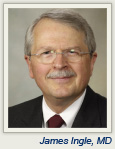 James Ingle, MD, of the Mayo Clinic, Rochester, Minnesota, formally discussed the ABCSG-12 and ZO-FAST bisphosphonate studies presented at the 2011 San Antonio Breast Cancer Symposium, noting, “There is a lot of interest in the effect of bisphosphonates on the tumor microenvironment and the impact of bisphosphonates on modifying the recruitment of bone marrow precursors that may be related to the spread of cancer.”
James Ingle, MD, of the Mayo Clinic, Rochester, Minnesota, formally discussed the ABCSG-12 and ZO-FAST bisphosphonate studies presented at the 2011 San Antonio Breast Cancer Symposium, noting, “There is a lot of interest in the effect of bisphosphonates on the tumor microenvironment and the impact of bisphosphonates on modifying the recruitment of bone marrow precursors that may be related to the spread of cancer.”
In the previous AZURE trial, the overall effect of zoledronic acid was negative, but there was significant heterogeneity among subsets. Women who were peri- or premenopausal had no benefit, but postmenopausal patients had improvements in disease-free and overall survival with zoledronic acid.
Now, the long-term results of Austrian Breast and Colorectal Cancer Study Group (ABCSG)-12 showed significant improvements in disease-free and overall survival, and reductions in locoregional recurrence, distant recurrence, and contralateral breast cancers.
“And this was the ideal study,” Dr. Ingle concluded. “It was prospectively designed with the appropriate endpoint, and it robustly established those endpoints,” he said.
Level 1 Evidence
“My conclusion is that ABCSG-12 provides level 1 evidence for the value of zoledronic acid as adjuvant therapy in premenopausal women receiving goserelin plus tamoxifen or anastrozole, or, one might argue, any third-generation aromatase inhibitor. It was safe and effective, and it is a new standard of care,” he said.
Dr. Ingle emphasized, however, that he would not give zoledronic acid to premenopausal women receiving tamoxifen alone. “Absolutely not,” he said in a media briefing.
ZO-FAST: Not So Fast
Regarding the ZO-FAST data, Dr. Ingle noted that these findings are “consistent with other recent studies of zoledronic acid” that suggest adjuvant bisphosphonates are of value in women with a low-estrogenic environment.
“The magnitude of improvement in ZO-FAST has been accepted to be clinically important in other areas,” he noted. However, the value demonstrated in postmenopausal women was based on an unplanned analysis, he pointed out. “Thus, the data are insufficient to support zoledronic acid as the standard of care in postmenopausal women,” he maintained.
Regarding the use of zoledronic acid based on the findings from these trials, Dr. Ingle posed a few questions. “Are premenopausal women treated with ovarian function suppression, as in ABCSG-12, the same as postmenopausal women?” he asked. “Perhaps, but not necessarily, and we cannot directly extrapolate ABCSG-12 results to postmenopausal women.”
As for clodronate and ibandronate, NSABP B-34 and the GAIN trial provided “clues” that uphold some consistency of value for bisphosphonates in the low-estrogenic environment. “At the 30-foot level, they are both negative studies, but with close examination, the findings with respect to an age effect are consistent with this theme,” he said.
Other issues remain, he said, regarding the use of bisphosphonates in breast cancer: relative efficacy per type of bisphosphonate, impact of age (eg, < 40 years), degree of estrogen suppression, impact of adjuvant chemotherapy, and optimal schedule and duration of treatment. Ongoing studies will provide more data.
Unanswered questions notwithstanding, Dr. Ingle concluded, “mounting evidence suggests that bisphosphonates will become established as efficacious in the adjuvant treatment of postmenopausal women with early breast cancer.” ■
Disclosure: Dr. Ingle reported no potential conflicts of interest.

